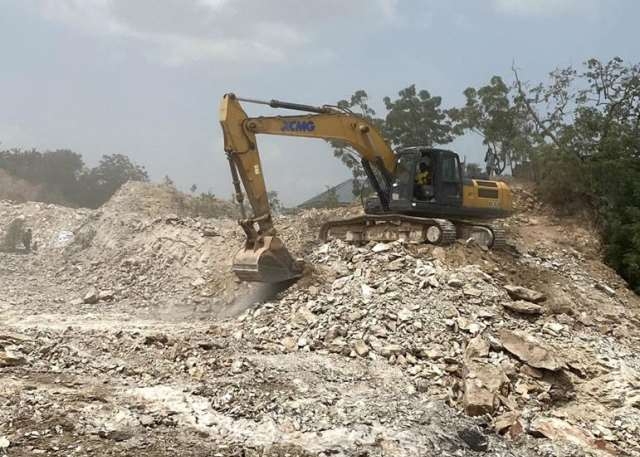In the Western Region, a long-simmering tension between the Ghanaian Development Company (GDC) quarry and residents of Essipon has re-emerged with renewed intensity. The latest episode in the escalating dispute centers around allegations of excessive blasting and unsafe quarrying practices, which residents claim are threatening their lives, homes, and peace of mind. The community’s appeals to both municipal and national authorities reflect a growing anxiety over environmental safety and the lack of corporate accountability in extractive operations conducted near residential settlements.
Essipon, a town on the outskirts of Sekondi-Takoradi, has evolved into a semi-urban enclave with increasing residential developments over the last two decades. However, this growth has been persistently overshadowed by the activities of the GDC quarry, located perilously close to homes and public structures. According to residents, the frequent detonation of explosives has led to the development of structural cracks in buildings, recurrent noise pollution, and a persistent state of psychological distress among locals, particularly children and the elderly. The latest altercation surfaced after a series of loud blasting incidents in early June 2025. These activities reportedly sent shockwaves through surrounding neighborhoods, shaking walls, damaging rooftops, and propelling dust into the atmosphere. Videos circulated on social media platforms, most notably a broadcast by Spice 91.9 FM, captured frustrated residents demanding immediate intervention. Community leaders, speaking in the Twi language, passionately expressed their grievances, describing the quarry’s operations as “terrorizing the people under the veil of industrial development.” One resident recounted a particularly harrowing experience where shattered window panes from a nearby explosion injured her son. Others described how the structural integrity of their homes continues to deteriorate, with visible fissures in concrete walls and floors. While many communities across Ghana live in proximity to industrial zones, the case in Essipon is especially contentious because of the perceived encroachment of GDC’s operations into officially zoned residential areas.
Historical records reveal that the friction between the quarry and Essipon residents is not new. As far back as 2013, similar complaints were lodged against the company. At the time, the Sekondi-Takoradi Metropolitan Assembly (STMA) was petitioned to investigate the company’s compliance with local zoning ordinances and environmental safety regulations. However, residents claim that these investigations yielded little action and that the situation has only worsened in the years since. The Environmental Protection Agency (EPA) of Ghana has clear regulations regarding buffer zones for quarrying activities. Under Legislative Instrument 2177 of 2012, quarry operators are required to maintain a minimum distance, typically around 500 meters, from residential structures before blasting can be legally conducted. Many residents argue that GDC’s current site violates this provision and are calling for an independent environmental and structural audit to determine the level of damage already caused. Despite the gravity of the accusations, GDC has yet to issue a formal, public response. Although the community anticipated a statement following the widespread media attention, particularly the coverage by Spice 91.9 FM, no such clarification or defense has been made available at the time of writing. This silence has only served to deepen public mistrust and galvanize civic action. Multiple residents have signaled their intention to pursue legal recourse, citing breaches of their constitutional right to a safe and secure living environment.
Furthermore, local assembly members and opinion leaders are now actively engaging with the EPA, Minerals Commission, and the STMA to demand an immediate cessation of quarrying operations until a full-scale investigation is conducted. They are also advocating for compensation schemes to be set up for affected households, many of which have been forced to carry out costly repairs on their own. Some homes, residents claim, may be beyond repair. Beyond the immediate health and safety concerns lies a broader question of governance and land-use planning. The controversy calls into question how urban expansion is being managed in resource-rich areas like Sekondi-Takoradi. If local authorities are issuing permits without strict adherence to zoning regulations or failing to enforce compliance from industrial operators, it sets a dangerous precedent not just for Essipon but for other peri-urban communities across Ghana.
The GDC quarry incident also highlights the ongoing challenge of balancing economic development with social responsibility. While quarrying and mining play vital roles in Ghana’s economy, contributing to infrastructure development, job creation, and raw material supply, the operations must be carried out per international safety standards and local regulatory frameworks. Anything less threatens not only lives and property but also the legitimacy of institutions entrusted with ensuring equitable development. As of now, the residents of Essipon await tangible action from the authorities. The absence of a corporate response from GDC is increasingly being interpreted as either an admission of negligence or an intentional strategy to avoid accountability. Civil society organizations and legal aid groups are already mobilizing to assist the community, and if no resolution is forthcoming, the dispute may ultimately find its way to the courts.
The events unfolding in Essipon underscore a critical need for reform in Ghana’s industrial oversight mechanisms. It is a clarion call for a more robust, transparent, and citizen-centered approach to development—one in which communities are not merely passive spectators to the decisions that shape their environments, but active participants with the power to hold corporations and institutions to account.

